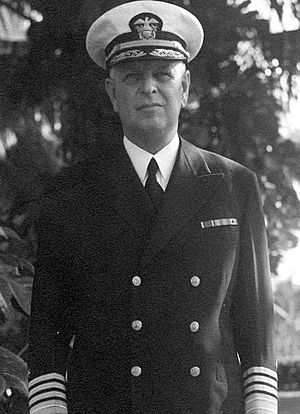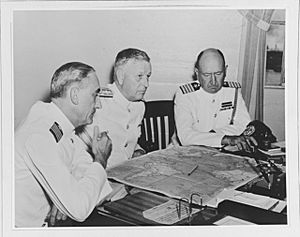Husband E. Kimmel facts for kids
Quick facts for kids
Husband E. Kimmel
|
|
|---|---|

Admiral Husband E. Kimmel in 1941
|
|
| Birth name | Husband Edward Kimmel |
| Nickname(s) | "Kim", "Hubbie", and "Mustafa" |
| Born | February 26, 1882 Henderson, Kentucky, U.S. |
| Died | May 14, 1968 (aged 86) Groton, Connecticut, U.S. |
| Allegiance | |
| Service/ |
|
| Years of service | 1904–1942 |
| Rank | |
| Commands held | USS New York Cruiser Division 7 Cruisers, Battle Force United States Pacific Fleet |
| Battles/wars | Mexican Revolution
|
| Awards | Mexican Service Medal World War I Victory Medal World War II Victory Medal |
Husband Edward Kimmel (born February 26, 1882 – died May 14, 1968) was a high-ranking United States Navy admiral. He was the top commander of the United States Pacific Fleet when Japan attacked Pearl Harbor in December 1941. After the attack, he was removed from his command. He retired from the Navy in early 1942. Years later, in 1999, the U.S. Senate voted to give him back his full rank, but this was never officially done by the President.
Contents
Who Was Admiral Kimmel?
Early Life and Family
Husband Kimmel was born in Henderson, Kentucky, on February 26, 1882. His parents were Sibella "Sibbie" Lambert Kimmel and Major Manning M. Kimmel. His father was a graduate of West Point, a famous military academy. He fought in the American Civil War.
Kimmel had several nicknames, including "Kim" and "Hubbie." He was also called "Mustafa" because his last name, Kimmel, sounded a bit like "Kemal," which was part of the name of a famous Turkish leader, Mustafa Kemal Atatürk.
He married Dorothy Kinkaid, who was the sister of another admiral, Thomas C. Kinkaid. They had three sons: Manning, Thomas K. Kimmel, and Edward R. Kimmel.
Kimmel finished his studies at the United States Naval Academy in Annapolis, Maryland, in 1904. From 1906 to 1907, he served on several large warships called battleships in the Caribbean Sea. In 1907, he joined the USS Georgia as it sailed around the world with the Great White Fleet.
Later, in April 1914, he was wounded during the United States occupation of Veracruz, Mexico. In 1915, he worked briefly for Franklin D. Roosevelt, who would later become President. During World War I, Kimmel was an officer in charge of guns on battleships that worked with the British Navy.
After the war, he served on the battleship USS Arkansas. He also commanded groups of smaller ships called destroyers. In 1926, he became a captain after finishing a course at the Naval War College. From 1926 to 1937, Kimmel held many jobs in the Navy. He also commanded a destroyer group and the battleship USS New York.
In 1937, he was promoted to rear admiral. In this role, he commanded a group of cruisers, which are fast warships, on a trip to South America. In 1939, he became the commander of all the cruisers in the Battle Force.
The Attack on Pearl Harbor
In February 1941, Admiral Kimmel was chosen to be the new Commander in Chief of the United States Pacific Fleet. This was a very important job. Kimmel was known as a hard worker who inspired the people who worked for him. Some people later said he paid too much attention to small details. However, his gunnery officer, Willard Kitts, said that under Kimmel, the fleet was "at its highest level" of training and efficiency. Admiral William "Bull" Halsey, a famous admiral, called Kimmel "the ideal man for the job."
The main base for the Pacific Fleet had been moved from San Diego, California, to Pearl Harbor, Hawaii, in May 1940. The previous commander had worried about the fleet being vulnerable there. On February 18, 1941, Kimmel wrote to the Navy's top officer, Admiral Harold Rainsford Stark, saying: "I think a surprise attack (by submarines, planes, or both) on Pearl Harbor is possible. We are taking steps to reduce damage and make sure the attackers pay a price."
Kimmel also asked for more resources to defend other islands like Wake Island and Midway. In November 1941, Kimmel sent two important aircraft carriers, USS Enterprise and USS Lexington, away from Pearl Harbor to deliver planes to these islands. Because of these missions, neither carrier was at Pearl Harbor when the Japanese attacked.
Japan's attack on Pearl Harbor happened on December 7, 1941. It was an air raid that killed 2,403 U.S. military members and civilians. During the attack, Kimmel was in his office. A bullet from a machine gun crashed through his window, hitting his jacket and leaving a mark on his chest. He reportedly said, "It would have been merciful had it killed me." A naval serviceman who was with Kimmel recalled that he tore off his four-star shoulder marks, as if knowing his command was about to end.
After the Attack
Kimmel was removed from his command ten days after the attack. At that time, he was planning ways to fight back. Vice Admiral William S. Pye took over temporarily. Admiral Chester W. Nimitz became the new commander of the Pacific Fleet on December 31.
In 1941, a group called the Roberts Commission investigated the attack. They decided that Kimmel and the Army general in charge, Walter Short, had made mistakes and were not prepared enough for the attack. Kimmel defended himself in several hearings, saying he had not been given all the important information.
Later, in 1944, a Naval Court of Inquiry was held. This court largely cleared Kimmel of blame. It found that Kimmel's decisions were correct based on the limited information he had. It also criticized Admiral Harold R. Stark, the Navy's top officer, for not warning Kimmel that war was about to begin. The court said that "no offenses have been committed nor serious blame incurred" by Navy personnel. However, this report was kept secret until after the war because it revealed that American codebreakers had secretly understood Japanese messages.
The Secretary of the Navy, James Forrestal, disagreed with some of the court's findings. He felt Kimmel could have done more to prevent or lessen the attack. Forrestal concluded that both Kimmel and Stark "failed to show the excellent judgment needed for their high ranks and duties."
Kimmel retired in early 1942. After the war, he worked for a military company. He died in Groton, Connecticut, on May 14, 1968.
His son, Manning, died when the submarine he commanded, the USS Robalo, sank in July 1944. It was later believed that Manning was one of a few survivors who were captured by Japanese forces and died tragically as prisoners of war.
What People Thought Later
Historians generally agree that the United States was not ready for the Japanese attack on Pearl Harbor. The Japanese military was better trained and prepared at that time. How much Kimmel was personally responsible for the fleet's unreadiness has been a big debate.
Some people, like submarine Captain Edward L. "Ned" Beach, believed that Admiral Kimmel and General Short were unfairly blamed for mistakes made by higher-ups in Washington. Kimmel's supporters point to problems with communication and other issues that were beyond his control. For example, a warning message from Washington was delayed because of bad radio conditions and had to be sent as a telegram, which arrived after the attack began.
Edwin T. Layton, Kimmel's chief intelligence officer, supported Kimmel. He said Kimmel did not have complete information and used the resources he had in the best way possible.
On the other hand, Kimmel's critics say he had been ordered to prepare the fleet for defense ten days before the attack. They say he thought the main danger was sabotage, so he kept many ships in port and did not put the fleet on high alert. When his intelligence team lost track of Japan's aircraft carriers, he did not order long-range patrols to find them. He also did not work well with General Short, who was in charge of defending the fleet while it was in port.
Most historians believe that even if Kimmel had acted differently, American forces would still have struggled. Admiral Chester Nimitz, who took over after Kimmel, said in 1964 that "It was God's mercy that our fleet was in Pearl Harbor on December 7." He meant that if Kimmel had known the Japanese were coming, he might have tried to meet them at sea. But the Japanese carriers were much faster than Kimmel's battleships. This could have led to many more ships being lost in deep water and thousands more lives. Instead, at Pearl Harbor, many sailors were rescued, and six of the eight battleships were later repaired and used again.
In 1994, Kimmel's family tried for the third time to have his four-star rank restored. Presidents Bill Clinton, Richard Nixon, and Ronald Reagan all denied this request. A 1995 study by the Pentagon said that other high-ranking officers were also responsible for the failure at Pearl Harbor, but it did not fully clear Kimmel.
On May 25, 1999, the United States Senate voted to clear Kimmel and Short of blame. They asked the President to give both men their full ranks back after their deaths. Senator Strom Thurmond called them "the two final victims of Pearl Harbor." The Senate's investigation in 2000 strongly supported Kimmel's actions. However, President Clinton and later presidents did not act on this resolution.
Portrayals in Movies
Kimmel has been shown in several movies and TV shows:
- In the 1965 film In Harm's Way, actor Franchot Tone played Kimmel as someone who was a victim of bad luck.
- The 1970 film Tora! Tora! Tora! showed Kimmel, played by Martin Balsam, in a way that made viewers feel sympathy for him. He was shown as a skilled commander dealing with poor communication and a lack of readiness.
- Andrew Duggan played Kimmel in the 1983 TV miniseries The Winds of War.
- Colm Feore played Kimmel in the 2001 movie Pearl Harbor.
- In Midway (2019), he was played by David Hewlett.
Military Awards
| Cuban Pacification Medal | Mexican Service Medal | World War I Victory Medal with one campaign star |
| American Defense Service Medal with "BASE" clasp |
Asiatic-Pacific Campaign Medal with one campaign star |
World War II Victory Medal |
See also
 In Spanish: Husband E. Kimmel para niños
In Spanish: Husband E. Kimmel para niños


